What is line of sight internet service?
Simply put, line-of-sight internet provides wireless internet connectivity to buildings that have a clear line of sight to a dedicated mast.
Read our guide on line of sight Internet (Fixed wireless)
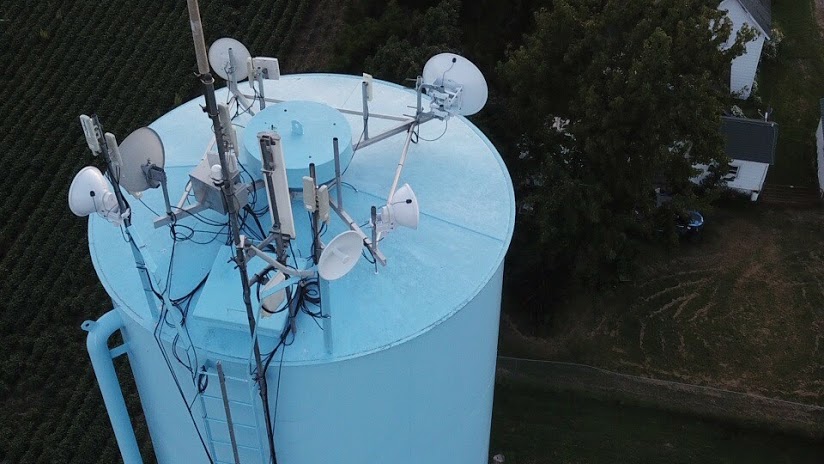
Introduction To Line of Sight internet.
Line of sight internet is a type of internet connection that uses a direct, unobstructed line of sight between the user’s device and a wireless transmitter to send and receive data. This is different from other types of internet connections that use things like cables or satellite dishes to transmit data.

One of the main advantages of line of sight internet is that it can provide very high speeds, since the data is sent directly from the transmitter to the user’s device. This makes it a good option for things like streaming video or online gaming, where you need a fast and reliable connection.
Another advantage of line of sight internet is that it is relatively easy to set up. In most cases, you just need to place the transmitter in a location that has a clear line of sight to the user’s device, and then connect the device to the transmitter using a wireless connection.
Overall, line of sight internet can be a great option for people who want a fast and reliable internet connection, especially in areas where other types of internet connectivity may be limited or unreliable. This means faster installation times, and less delays. Let’s take a look at some of these benefits here.
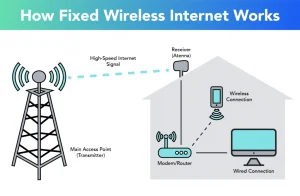
Benefits of line of sight internet:
- Faster Installation
Wireless Internet is much quicker to install than fiber optic. Wireless Internet can be installed in as little as 24 hours, with a typical installation time of 5-10 days. - High Reliability Line-of-sight
Internet by electromagnetic waves is less susceptible to external forces and easier to maintain, making connections more reliable. - Line of Sight Electromagnetic Internet is less susceptible to external forces and easier to maintain, making connections more reliable.

- Low Latency
The longer the data travels, the longer this process will take. Wireless microwave signals travel in a straight line from one point to the next, resulting in very low latency and fewer “hops” required. Microwave radio waves travel up to 189,000 miles per second. Microwaves Radio waves travel up to 189,000 miles per second. On the other hand, fiber connections must follow established routes such as roads. Each turn slows down the signal and increases latency. Data travels over large, inefficient cables to central offices, and signals travel up to 124,000 miles per second. - Pricing
Line of Sight Internet technology may seem more expensive than traditional fiber optic connections, but in reality costs are often comparable to, or even lower than, fiber optic connections. Become. Our Line of Sight Internet solution saves you 20-40% over fiber connections.
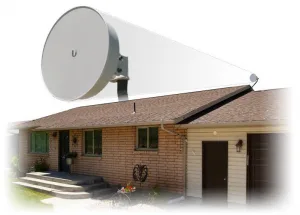
Line-of-sight broadband technology is expected to be more expensive than traditional fiber optic connections, but in reality the costs are similar to, or even lower than, fiber optic connections.
Is Line-of-Sight Internet the Solution? Our line-of-sight internet solutions cover a large area of southwest Missouri, please contact us. We would be happy to talk to you about your needs and situation.
Line-of-sight internet, also known as fixed wireless internet, is a type of internet connection that uses radio waves to transmit data between the provider’s antenna and the user’s receiver. This type of connection is a popular choice for rural areas where traditional wired internet options are not available.
One of the main advantages of line-of-sight internet is that it can provide high-speed internet access to remote locations that would otherwise be difficult to connect. This is because the radio waves used in this type of connection can travel long distances without interference, making it possible to connect even the most remote areas.
Another advantage of line-of-sight internet is that it is relatively easy to install and maintain. Unlike traditional wired internet connections, which require complex and often costly infrastructure, line-of-sight internet only requires a clear line of sight between the provider’s antenna and the user’s receiver. This means that it can be set up quickly and easily, without the need for complex installations or specialized equipment.
Despite its many advantages, line-of-sight internet is not without its drawbacks. One of the main challenges of this type of connection is that it is sensitive to interference from objects that block the line of sight between the antenna and the receiver. This can include trees, buildings, and other structures, which can affect the quality and reliability of the connection.
In addition, line-of-sight internet is not available in all areas. While it can be a great option for rural areas, it may not be suitable for urban areas where buildings and other structures can block the line of sight. In these cases, traditional wired internet connections may be a better option.
Overall, line-of-sight internet is a valuable option for providing high-speed internet access to remote and rural areas. While it has its limitations, it can be a cost-effective and reliable way to connect these areas to the internet.
Whats the differences between Line of sight and fixed wireless internet?
Line of sight (LOS) internet and fixed wireless internet are both types of internet connection that use radio waves to transmit data between a transmitting and receiving antenna. In both cases, the antennas must have a clear line of sight to each other in order to establish a stable connection. This means that there must be no obstacles, such as buildings or trees, blocking the path between the two antennas.
Both LOS internet and fixed wireless internet are typically used in rural or remote areas where it is difficult or impossible to install traditional wired internet infrastructure, such as cable or DSL. They can also be used as a backup internet connection for businesses or other organizations that need a reliable and redundant internet connection.
One key difference between LOS internet and fixed wireless internet is the distance over which the connection can be established. LOS internet typically has a shorter range, as the name suggests, and is typically used for connections over a few miles at most. Fixed wireless internet, on the other hand, can be used for connections over much longer distances, up to several tens of miles in some cases.
Another difference between the two types of internet connection is the speed and reliability of the connection. LOS internet can be susceptible to interference from obstacles such as buildings or trees, which can affect the speed and reliability of the connection. Fixed wireless internet, on the other hand, can provide a more stable and reliable connection over longer distances.
Overall, LOS internet and fixed wireless internet are similar in that they both use radio waves to transmit data between a transmitting and receiving antenna. However, they differ in the distance over which the connection can be established, as well as the speed and reliability of the connection.
Line of Sight Internet Gallery
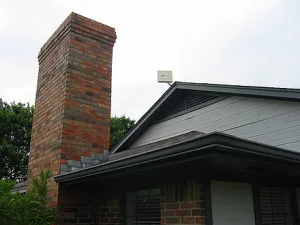

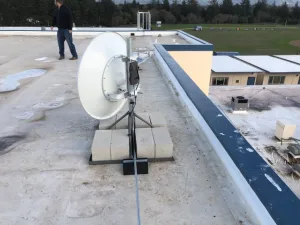
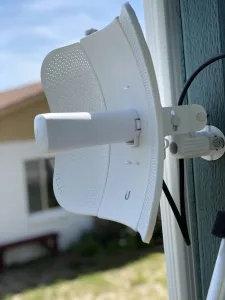


Example of Point-to-Multi-Point LoS Wireless Network
In the example, we have one access point supplying multiple clients with internet.
